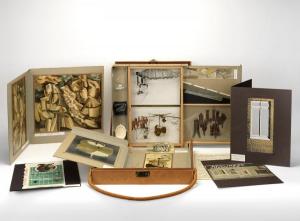As an elementary schooler at heart, I love field trips. And while trips in college no longer involve permission slips and yellow school buses, I still get excited when my classes venture out of the classroom. Here are a few of the most memorable examples from my time at UChicago!

Text & Performance: Staging Terror
Theatrical Productions
As part of the Core curriculum, I took a class called Text & Performance: Staging Terror, which focused on staging theatrical scenes of horror. In order to analyze how aspects of staging worked, we were assigned to see two plays in Chicago. The first I saw was Guess Who’s Coming to Dinner at Court Theatre, UChicago’s professional theater. An adaptation of the 1967 comedy film about an interracial couple announcing their engagement, my class discussed the way it added tension to the film’s themes by subtly suggesting, through its lighting and music, the contrast between the happy couple on stage and the persistent problems of race in society.
For the second production, I went downtown to Steppenwolf Theatre to see The Doppelgänger, a slapstick farce about a chaotic international negotiation. The play starred Rainn Wilson, known for his role as Dwight Schrute in The Office, and he did a great job of alternating between two drastically different characters as they were forced to impersonate each other in a series of rambunctiously funny mishaps.
Site-Specific Horror
For Staging Terror, we also developed our own short horror stagings. While most took place in the classroom, one set of stagings played with site-specific theater, in which the scene moved throughout the eleven-story arts building, the Logan Center, with the audience following behind. The Logan Center was built with an eye towards interaction with the space, and we took advantage of the different environments in some unexpected ways, with stagings that featured dramatic shrieking in the stairwell, ominous piano music wafting down a hallway of practice rooms, and a dramatic bridge sacrifice scene on the outdoor patio.

Reading Cultures
The Smart Museum
One of the main themes of my Humanities Core class, Reading Cultures, was collection: how collecting pieces brings them meaning, and how pieces bring meaning to their collections. In thinking about this idea, we visited the collection of art at the Smart Museum, UChicago’s fine arts museum, three times throughout the course. We spent each of these classes in the study room, where a selection of art from the Smart’s collection was placed out for us to examine up close. Among the art we saw were two renderings of the Narcissus and Echo myth from Ovid’s Metamorphoses, a sculpture and an ink engraving, as well as a selection of Carrie Mae Weems’s photographs exploring African-American identity.
For me, the most memorable piece we saw at the Smart was Marcel Duchamp’s Boîte-en-valise, a portable suitcase containing small reproductions of Duchamp’s other works. The box itself was reproduced in 312 intricately crafted iterations, two of which have a home at the Smart Museum. We discussed several of the individual pieces, like a tongue-in-cheek print of the Mona Lisa with a mustache and goatee. We also discussed how the pieces were presented within the suitcase, thinking about how the art’s reproduction and repurposing altered our understanding of it.
Regenstein Special Collections
For Reading Cultures, we also visited the Special Collections Research Center, which houses the Regenstein Library’s collection of rare and valuable books. We looked at historical printings of Homer’s The Odyssey, including several editions that contained beautiful full-page illustrations, and discussed how the myth’s portrayal changed based on the context in which it was printed. For instance, one version of the story, presented as a children’s book, rearranged the mythology to give it a clearer structure and frame Odysseus as a more clear-cut protagonist.

Alternate Reality Games
A LARP
For my Alternate Reality Games class, I recently participated in a LARP, or live action role-playing game. Like a cross between Dungeons & Dragons and improvisational theater, the game was a very dorky and very fun couple hours of fantasy worldbuilding. I played Wesley Wood, an angsty teenager dabbling in dark magic, and over the course of the game, I complained about my classmates at a picnic, conducted magic rituals, and helped protect an invisible warlock. After spending hours in character, I emerged from the game feeling like I’d woken up from a dream.
In class, we discussed how players interacted with the game mechanics and shaped the narrative, as well as the ways in which the game organizers adapted to our decisions and expectations. We also discussed the concept of “bleed,” in which performing as a character affects the player’s feelings or vice versa.
These experiences outside of the classroom all brought valuable ideas back to class, strengthening course concepts while creating fun and unique memories.